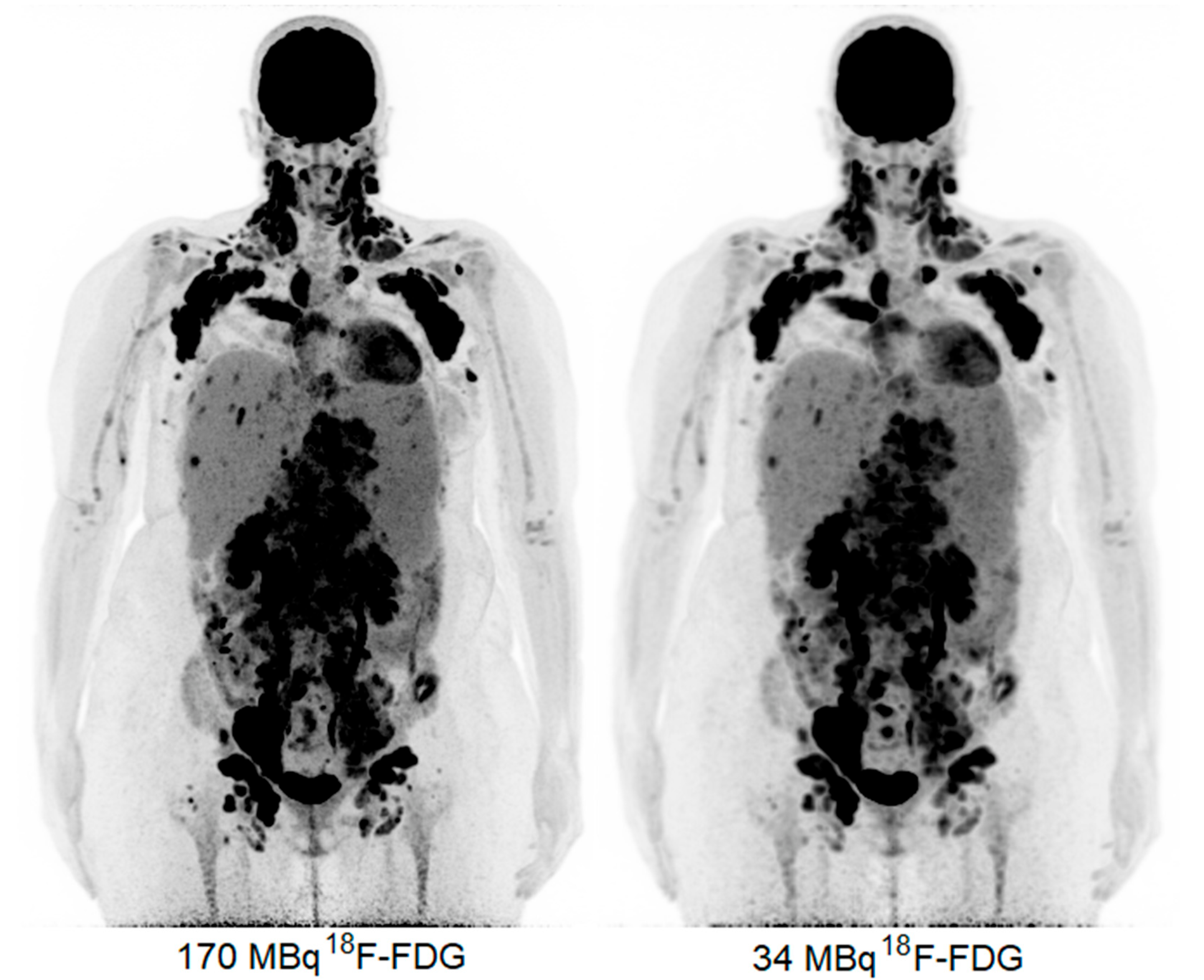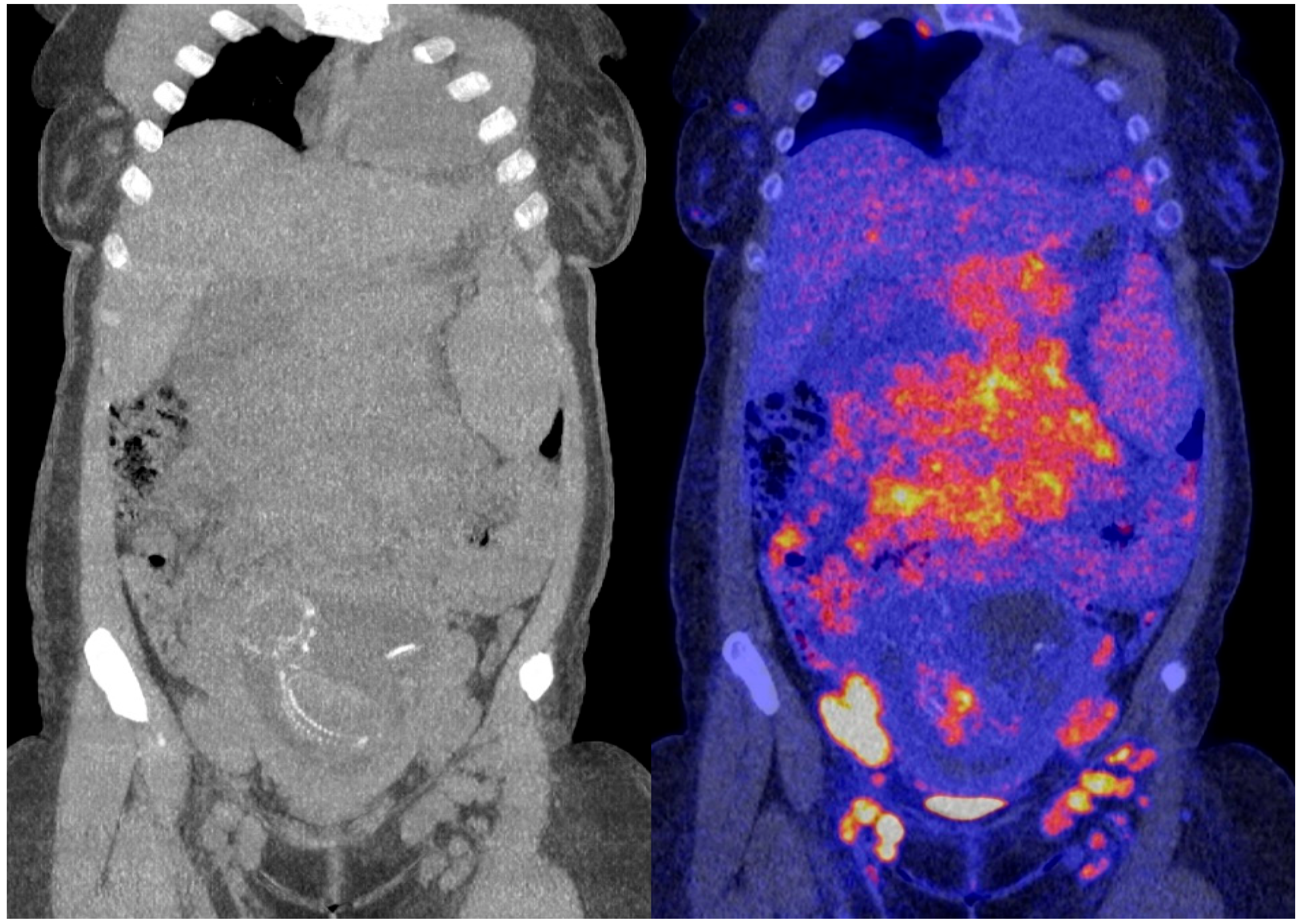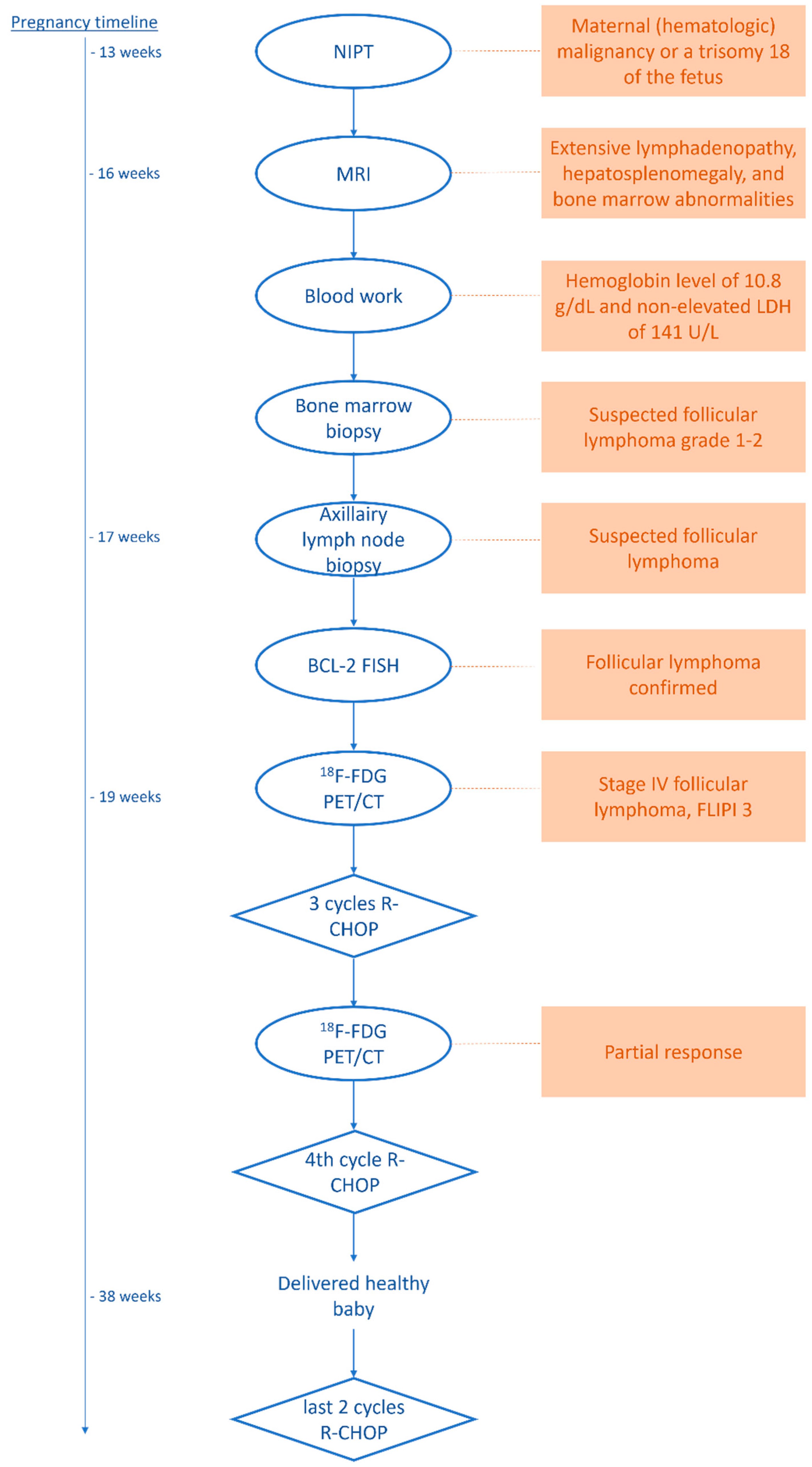Long Axial Field-of-View PET for Ultra-Low-Dose Imaging of Non-Hodgkin Lymphoma during Pregnancy
Abstract
1. Introduction
2. Case Presentation
3. Discussion
4. Conclusions
Author Contributions
Funding
Institutional Review Board Statement
Informed Consent Statement
Data Availability Statement
Conflicts of Interest
References
- Freedman, A. Foillicular lymphoma: 2015 Update on diagnosis and management. Am. J. Hematol. 2015, 90, 739–745. [Google Scholar] [CrossRef] [PubMed]
- Bastiaannet, E.; Groen, B.; Jager, P.L.; Cobben, D.C.P.; van der Graaf, W.T.A.; Vaalburg, W.; Hoekstra, H.J. The value of FDG-PET in the detection, grading and response to therapy of soft tissue and bone sarcomas: A systematic review and meta-analysis. Cancer Treat. Rev. 2004, 30, 83–101. [Google Scholar] [CrossRef] [PubMed]
- Slomka, P.J.; Pan, T.; Germano, G. Recent Advances and Future Progress in PET Instrumentation. Semin. Nucl. Med. 2016, 46, 5–19. [Google Scholar] [CrossRef] [PubMed]
- Hsu, D.F.C.; Ilan, E.; Peterson, W.T.; Uribe, J.; Lubberink, M.; Levin, C.S. Studies of a Next-Generation Silicon-Photomultiplier–Based Time-of-Flight PET/CT System. J. Nucl. Med. 2017, 58, 1511–1518. [Google Scholar] [CrossRef] [PubMed]
- Townsend, D.W. Dual-Modality Imaging: Combining Anatomy and Function. J. Nucl. Med. 2008, 49, 938–955. [Google Scholar] [CrossRef]
- Boellaard, R.; Delgado-Bolton, R.; Oyen, W.J.G.; Giammarile, F.; Tatsch, K.; Eschner, W.; Verzijlbergen, F.J.; Barrington, S.F.; Pike, L.C.; Weber, W.A.; et al. FDG PET/CT: EANM procedure guidelines for tumour imaging: Version 2.0. Eur. J. Nucl. Med. Mol. Imaging 2014, 42, 328–354. [Google Scholar] [CrossRef]
- Boellaard, R.; Oyen, W.J.G.; Hoekstra, C.J.; Hoekstra, O.S.; Visser, E.P.; Willemsen, A.T.; Arends, B.; Verzijlbergen, F.J.; Zijlstra, J.; Paans, A.M.; et al. The Netherlands protocol for standardisation and quantification of FDG whole body PET studies in multi-centre trials. Eur. J. Nucl. Med. Mol. Imaging 2008, 35, 2320–2333. [Google Scholar] [CrossRef]
- Surti, S.; Viswanath, V.; Daube-Witherspoon, M.E.; Conti, M.; Casey, M.E.; Karp, J.S. Benefit of improved performance with state-of-the art digital PET/CT for lesion detection in oncology. J. Nucl. Med. 2020, 61, 1684–1690. [Google Scholar] [CrossRef]
- Slart, R.H.J.A.; Tsoumpas, C.; Glaudemans, A.W.J.M.; Noordzij, W.; Willemsen, A.T.M.; Borra, R.J.H.; Dierckx, R.A.J.O.; Lammertsma, A.A. Long axial field of view PET scanners: A road map to implementation and new possibilities. Eur. J. Nucl. Med. Mol. Imaging 2021, 48, 4236–4245. [Google Scholar] [CrossRef]
- Vandenberghe, S.; Moskal, P.; Karp, J.S. State of the art in total body PET. EJNMMI Phys. 2020, 7, 35. [Google Scholar] [CrossRef]
- Prenosil, G.A.; Sari, H.; Fürstner, M.; Afshar-Oromieh, A.; Shi, K.; Rominger, A.; Hentschel, M. Performance Characteristics of the Biograph Vision Quadra PET/CT system with long axial field of view using the NEMA NU 2-2018 Standard. J. Nucl. Med. 2021, 63, 476–484. [Google Scholar] [CrossRef]
- Van Sluis, J.; De Jong, J.; Schaar, J.; Noordzij, W.; Van Snick, P.; Dierckx, R.; Borra, R.; Willemsen, A.; Boellaard, R. Performance Characteristics of the Digital Biograph Vision PET/CT System. J Nucl Med 2019, 60, 1031–1036. [Google Scholar] [CrossRef]
- van Sluis, J.; van Snick, J.H.; Brouwers, A.H.; Noordzij, W.; Dierckx, R.A.J.O.; Borra, R.J.H.; Slart, R.H.J.A.; Lammertsma, A.A.; Glaudemans, A.W.J.M.; Boellaard, R.; et al. EARL compliance and imaging optimisation on the Biograph Vision Quadra PET/CT using phantom and clinical data. Eur. J. Nucl. Med. Mol. Imaging 2022, 49, 4652–4660. [Google Scholar] [CrossRef]
- ICRP. Pregnancy and Medical Radiation, ICRP Publication 84: Approved by the Commission in November 1999. Ann. ICRP 2000, 30, 1. [Google Scholar] [CrossRef]
- Stabin, M.G. Proposed addendum to previously published fetal dose estimate tables for 18F-FDG. J. Nucl. Med. 2004, 45, 634–635. [Google Scholar]
- Benveniste, H.; Fowler, J.S.; Rooney, W.D.; Moller, D.H.; Backus, W.W.; Warner, D.A.; Carter, P.; King, P.; Scharf, B.; Alexoff, D.A.; et al. Maternal-fetal in vivo imaging: A combined PET and MRI study. J. Nucl. Med. 2003, 44, 1522–1530. [Google Scholar]
- van de Schans, S.A.M.; Steyerberg, E.W.; Nijziel, M.R.; Creemers, G.J.; Janssen-Heijnen, M.L.; van Spronsen, D.J. Validation, revision and extension of the follicular lymphoma international prognostic index (FLIPI) in a population-based setting. Ann. Oncol. 2009, 20, 1697–1702. [Google Scholar] [CrossRef]
- Boellaard, R.; Kaalep, A.; Sera, T.; Oyen, W.; Krause, B.J.; Chiti, A.; Liu, Y. New Developments of EANM Oncology PET/CT Guidelines and Update of the EARL Accreditation Standards Presentation. Eur. J. Nucl. Med. Mol. Imaging 2018, 45, 412–422. [Google Scholar]
- Calais, J.; Hapdey, S.; Tilly, H.; Vera, P.; Chastan, M. Hodgkin’s Disease Staging by FDG PET/CT in a Pregnant Woman. Nucl. Med. Mol. Imaging 2014, 48, 244–246. [Google Scholar] [CrossRef]
- Pijl, J.P.; Londema, M.; Kwee, T.C.; Nijsten, M.W.N.; Slart, R.H.J.A.; Dierckx, R.A.J.O.; van der Voort, P.H.J.; Glaudemans, A.W.J.M.; Pillay, J. FDG-PET/CT in intensive care patients with bloodstream infection. Crit. Care 2021, 25, 1–12. [Google Scholar] [CrossRef]
- Maiga, A.W.; Deppen, S.A.; Mercaldo, S.F.; Blume, J.D.; Montgomery, C.; Vaszar, L.T.; Williamson, C.; Isbell, J.M.; Rickman, O.B.; Pinkerman, R.; et al. Assessment of fluorodeoxyglucose F18–Labeled positron emission tomography for diagnosis of high-Risk lung nodules. JAMA Surg. 2018, 153, 329–334. [Google Scholar] [CrossRef] [PubMed]
- Surti, S.; Pantel, A.R.; Karp, J.S. Total Body PET: Why, How, What for? IEEE Trans. Radiat. Plasma Med. Sci. 2021, 4, 283–292. [Google Scholar] [CrossRef] [PubMed]
- Torizuka, T.; Tanizaki, Y.; Kanno, T.; Futatsubashi, M.; Yoshikawa, E.; Okada, H. Single 20-Second Acquisition of Clinical Feasibility for Lung Cancer. J. Nucl. Med. 2009, 50, 1579–1584. [Google Scholar] [CrossRef]
- Lu, Y.; Fontaine, K.; Mulnix, T.; Onofrey, J.A.; Ren, S.; Panin, V.; Jones, J.; Casey, M.E.; Barnett, R.; Kench, P.; et al. Respiratory Motion Compensation for PET/CT with Motion Gated PET Data. J. Nucl. Med. 2018, 59, 1480–1486. [Google Scholar] [CrossRef] [PubMed]
- Pantel, A.R.; Viswanath, V.; Daube-witherspoon, M.E.; Dubroff, J.G.; Muehllehner, G.; Parma, M.J.; Pryma, D.A.; Schubert, E.K.; Mankoff, D.A.; Karp, J.S. PennPET Explorer: Human Imaging on a Whole-Body Imager. J. Nucl. Med. 2020, 61, 144–151. [Google Scholar] [CrossRef]
- Badawi, R.D.; Shi, H.; Hu, P.; Chen, S.; Xu, T.; Price, P.M.; Ding, Y.; Spencer, B.A.; Nardo, L.; Liu, W.; et al. First human imaging studies with the explorer total-body PET scanner. J. Nucl. Med. 2019, 60, 299–303. [Google Scholar] [CrossRef]
- Lee, J.W.; Kim, S.; Lee, S.M.; Moon, S.H.; Kim, T. Detection of Hepatic Metastases Using Dual-Time-Point FDG PET/CT Scans in Patients with Colorectal Cancer. Mol. Imaging Biol. 2011, 13, 565–572. [Google Scholar] [CrossRef]



Disclaimer/Publisher’s Note: The statements, opinions and data contained in all publications are solely those of the individual author(s) and contributor(s) and not of MDPI and/or the editor(s). MDPI and/or the editor(s) disclaim responsibility for any injury to people or property resulting from any ideas, methods, instructions or products referred to in the content. |
© 2022 by the authors. Licensee MDPI, Basel, Switzerland. This article is an open access article distributed under the terms and conditions of the Creative Commons Attribution (CC BY) license (https://creativecommons.org/licenses/by/4.0/).
Share and Cite
van Sluis, J.; Bellido, M.; Glaudemans, A.W.J.M.; Slart, R.H.J.A. Long Axial Field-of-View PET for Ultra-Low-Dose Imaging of Non-Hodgkin Lymphoma during Pregnancy. Diagnostics 2023, 13, 28. https://doi.org/10.3390/diagnostics13010028
van Sluis J, Bellido M, Glaudemans AWJM, Slart RHJA. Long Axial Field-of-View PET for Ultra-Low-Dose Imaging of Non-Hodgkin Lymphoma during Pregnancy. Diagnostics. 2023; 13(1):28. https://doi.org/10.3390/diagnostics13010028
Chicago/Turabian Stylevan Sluis, Joyce, Mar Bellido, Andor W. J. M. Glaudemans, and Riemer H. J. A. Slart. 2023. "Long Axial Field-of-View PET for Ultra-Low-Dose Imaging of Non-Hodgkin Lymphoma during Pregnancy" Diagnostics 13, no. 1: 28. https://doi.org/10.3390/diagnostics13010028
APA Stylevan Sluis, J., Bellido, M., Glaudemans, A. W. J. M., & Slart, R. H. J. A. (2023). Long Axial Field-of-View PET for Ultra-Low-Dose Imaging of Non-Hodgkin Lymphoma during Pregnancy. Diagnostics, 13(1), 28. https://doi.org/10.3390/diagnostics13010028







